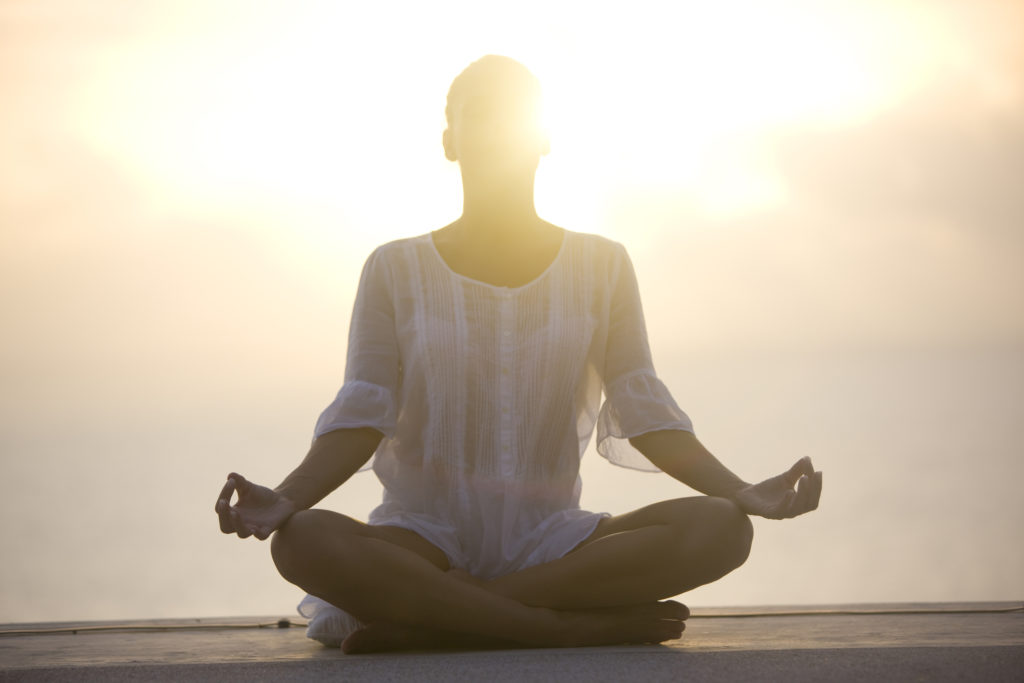
Yoga is a practice of aligning to your divineness. Or you could say that self-realization is the goal of human life. Patañjāli, the author of the Yoga Sutras, in an effort to make this idea or journey more understandable, and therefore attainable, suggests following what he calls “Astānga Yoga-The Eight Limbs of Yoga” as steps to the realization of your ultimate truth.
The eight steps are:
1. The Yama’s, ethical disciplines towards others
2. The Niyamas, ethical disciplines toward ourselves
3. Ᾱsana, postures
4. Prānāyāma, breathing techniques
5. Pratyāhāra, withdrawal of the senses
6. Dhāranā, mental concentration
7. Dhyāna, meditation
8. Samādhi, nirvana
This journey lasts a lifetime, or many, and those of us that practice Yoga are students for life. Most of us start by going to a Yoga class. “When the student is ready the teacher appears” is a quote I love. Hopefully, you will have the good fortune of following a teacher who has had their own practice for many years and is versed in all aspects of Yoga. Usually the first thing you, the student (sādhaka), learns is āsana or postures. Detailed instruction in the alignment of a posture personalized to your body takes a skilled practitioner. This is imperative so that you move toward alignment not injury.
The student begins to be aware of how one posture feels differently from other postures, but even more intriguing is how the posture feels different from day to day. In addition, and even more importantly, the student will notice what each of the postures does for the body, the feeling the body is left with, having experienced the pose. The key word here is “aware”. It is this awareness that connects the mind, body and breath. As these postures are practiced with consistency over time, they become easier, as the body attunes to correct posture, and then more difficult variations can be added. A habit of “being aware” starts to spread into the student’s life, not just in class but all of the time. The student feels a new sense of aligning to the world as this new-found physical alignment begins to take hold inside the body. What is making this happen in the body. As the body experiences each pose, it is placed in different shapes (a standing forward bend is different than a standing backward bend). Space is created in the body and prana with its healing capability, begins to make changes inside the body.
Next a student learns Prānāyāma, breathing techniques or the way that prana can be moved inside the body to create different affects. Ᾱyāma means length, expansion, stretching or restraint. Prānāyāma is the control over inhalation, exhalation, and retention. These practices enhance the alignment of the postures, and add to prāna’s (life force) healing affects. Again, awareness sets in. Now the student may realize that off the mat, they have a greater sense of energy (more life force) in their day to day lives.

By this time, discussions of the Yamas and Niyamas have become of interest to the student who is now somewhat aware that they are changing. They know they can affect that change, but maybe not the knowledge and they become curious. (It may take years to get to this point, but if you have a good teacher, they will have been advancing you to this place). Practicing the Yamas and Niyamas will help you to begin to align towards nature (or recognize what imbalances exist between yourself and the truth).
At this point the sādhaka is recognizing what is useful and not useful in their life. Sometimes the over stimulation of the outside world keeps us from remembering that we know how to live in a balanced state, we just have forgotten. By recognizing aspects of your day to day life that no longer serve you, you begin to distance yourself from these areas. Pratyāhāra, withdrawal of the senses, helps to take away the energy zapping tendencies of the outside world. This can be done simply by closing the door to your office or turning off the television for a few minutes, closing your eyes and simply taking some nice deep breaths. For a couple of days try not turning on the television or maybe when you are in your car driving, leave the radio off. At first it may be difficult as you are used to the stimulation, but it will not take long for your body to feel the calming sense of quiet. It is as if the central nervous system gets to take a vacation.
When the body has been aligned by āsana, when the mind has been cleared by prānāyāma and when the senses have been brought under control by pratyāhāra, mental concentration is now desired. Dhāranā brings the concentration of the sādhaka to a single point or task. For the mind to achieve a state of complete absorption, it must be stilled. The mind is an instrument found in every cell. It coordinates, classifies and judges all stimuli from the outside world and from those that arise from oneself. The mind has 5 states, each building off the other and culminating at the last stage called niruddha, where the mind, intellect, and ego are all quieted and offered to God. Without concentration on the Divine, which creates everything, one cannot find the divineness of oneself.

Dhyāna is the state of meditation. Uninterrupted flow of concentration brings on this state, as the yogi’s body, breath, senses, mind, reason and ego are all integrated in the object of his contemplation-Universal Consciousness. He remains conscious and sees the light that shines within himself and others.
At the peak of meditation, the sādhaka passes into the state of Samādhi. Still conscious, the body rests and the senses are quiet as if asleep, but the mind and reason are alert as if awake. The sense of “I” or “mine”, the lower mind, has stopped, and only pure consciousness, joy and bliss are experienced. True Yoga has been attained.
If you would like to experience this beautiful practice of Yoga or if you are already attending asana classes and would like learn pranayama, relaxation techniques and meditation, please contact me for a private session. You can contact me at peggybreeze@gmail.com and follow me on Facebook or at Instagram at Peggy_thebalancedyogi.
Thanks for reading and sharing with your friends. Please remember that Yoga does not take the place of physical fitness training in either cardio-respiratory or resistance training.
Until next time,
Peggy
